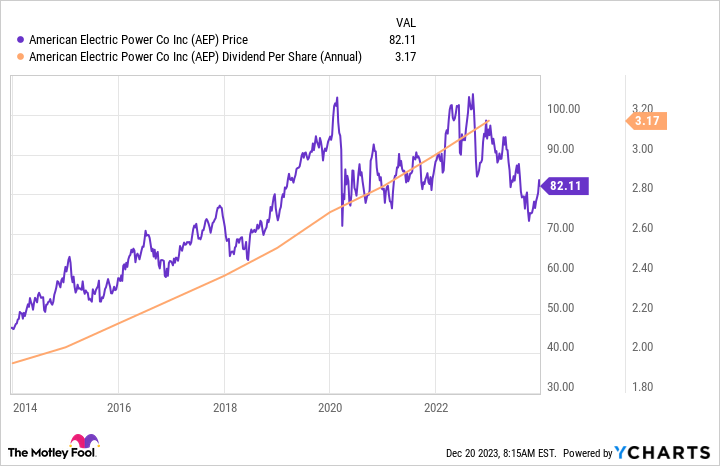This Utility Is Making a Smart Move to Lock in Smoother Results. Is It a Buy?

AEP (NASDAQ: AEP), also known as American Electric Power, operates regulated utilities in 11 states, making it one of the largest utilities in the United States. It just made an important shift in the way it runs its business, but the move should help it to produce smoother results. Here's what you need to know before you decide to buy this high-yielding dividend stock.
AEP just sold a business
In February 2023, AEP agreed to sell 1.365 gigawatts' worth of renewable power assets spanning 14 large-scale projects. The sale was completed in August, with proceeds of roughly $1.2 billion after taxes. But the money really wasn't the important factor here.

All of the assets that were sold were unregulated. While long-term fee-based contracts are the norm for assets like these, AEP still had to compete with other providers. This means that the company had to deal with market rates and balance that against the quality issues that surround customers. There is a material amount of risk involved in unregulated assets when compared to regulated assets.
A regulated asset is part of a utility that has been granted a monopoly in the region it serves. In exchange for that, the utility has to get rates and investment plans approved by the government. That tends to lead to slow and steady growth, but it usually protects companies from market risk. One of the most important aspects of running a regulated utility is ensuring that customers have reliable power. Regulators are generally happy to approve rates and investments that ensure such a thing, but they tend to put a cap on how much profit a utility will reap along the way. This is why utilities are often called "widow and orphan stocks," since they are deemed safe enough for such risk-averse investors to own.
In essence, what AEP has done by selling its non-regulated clean energy assets is to become a fully regulated utility. But it hasn't given up on clean energy -- not by a long shot.
AEP is focused on a safer clean energy future
The utility industry is making the transition from dirtier fuels to cleaner ones. So coal plants are being shut while solar and wind farms are being built. AEP's move to sell its unregulated clean energy assets would seem to run counter to that trend, which is true to some degree. It did sell a significant amount of clean energy capacity. But the goal is still to go green, just in a different manner.
For example, AEP plans to add 17 gigawatts of new clean energy resource opportunities over the next decade or so. It has a goal of reaching "net zero" by 2045. And its current capital budget includes $9 billion for regulated renewable power investments. The company is still very clearly on track for a much cleaner future.
The key difference is that the $9 billion it plans to spend will all be on assets where it gets rates approved by the government. That effectively locks in a decent return for the company. It is a vastly different story from an unregulated asset, where the market sets the rate. Essentially, it doesn't really matter what happens on Wall Street or in the economy; AEP's plans and financial returns on these projects are likely to be very close to what was expected because the regulators set the terms.
Slow and steady is the story here, with a far more certain outcome than before. Now add in AEP's fairly attractive 4.3% dividend yield. Note, too, that the dividend was increased 6% in the fourth quarter of 2023. That's a nice boost and an appealing yield, especially given that the average utility is yielding around 3.5%, using Vanguard Utilities Index ETF (NYSEMKT: VPU) as a proxy.
AEP won't excite you, but boring isn't a bad thing
Having gotten out of the unregulated clean energy space, AEP has sold off what some would have seen as a growth engine. That may be true, but it will allow the utility to focus on more predictable, regulated assets, which should translate into more consistent financial performance over time. For conservative income-focused investors, that will probably be a net win. Add in the above-average yield (which happens to be near its highest levels in a decade), and you might find you want to add this regulated utility to your portfolio today.
Should you invest $1,000 in American Electric Power right now?
Before you buy stock in American Electric Power, consider this:
The Motley Fool Stock Advisor analyst team just identified what they believe are the 10 best stocks for investors to buy now... and American Electric Power wasn't one of them. The 10 stocks that made the cut could produce monster returns in the coming years.
Stock Advisor provides investors with an easy-to-follow blueprint for success, including guidance on building a portfolio, regular updates from analysts, and two new stock picks each month. The Stock Advisor service has more than tripled the return of S&P 500 since 2002*.
*Stock Advisor returns as of December 18, 2023
Reuben Gregg Brewer has no position in any of the stocks mentioned. The Motley Fool has no position in any of the stocks mentioned. The Motley Fool has a disclosure policy.
This Utility Is Making a Smart Move to Lock in Smoother Results. Is It a Buy? was originally published by The Motley Fool

